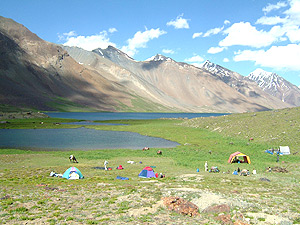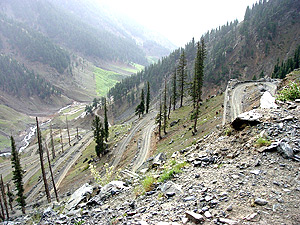Service & Area
Quick Links
Hindukush & Hindu Raj
 The Hindukush Mountains like the Himalaya are being fashioned before one’s very eyes. The numerous peaks, 200 of them rising above 6000m and a number over 7000m dominated by Tirich Mir at 7708m are ever thrusting upward 4 to 5 inches, each year. Only to be eroded by almost the same measurement and how spectacular this erosion can be, for this is a region of earthquakes, landslides and floods, a perpetual battleground where whole hillsides collapse overnight and fast-flowing rivers are forever carving out new gorges among the massifs.
The Hindukush Mountains like the Himalaya are being fashioned before one’s very eyes. The numerous peaks, 200 of them rising above 6000m and a number over 7000m dominated by Tirich Mir at 7708m are ever thrusting upward 4 to 5 inches, each year. Only to be eroded by almost the same measurement and how spectacular this erosion can be, for this is a region of earthquakes, landslides and floods, a perpetual battleground where whole hillsides collapse overnight and fast-flowing rivers are forever carving out new gorges among the massifs.
The Hindu Kush range, marks the watershed between the valleys draining the Amu “Oxus river “ in Pamirs at the roof of the world and the “ Indus river “ basin draining into the Arabian sea. This mountain range with its numerous valleys can be divided into three separate regions .
The eastern region extends from Wakhjir pass 4,907m in the little Pamir to Dorah pass 4,510m, a distance of about 320 km stretching along the China , Pakistan and Afghan frontier.
 The second region stretches beyond Dorah pass and lies in Afghanistan with the major peaks in Badkhashan and Nuristan..
The second region stretches beyond Dorah pass and lies in Afghanistan with the major peaks in Badkhashan and Nuristan..
The third region the Hindu Raj or the Thui range lies entirely in Pakistan stretching 240km along Swat and Kohistan valley.
Alexander the Great crossed the range in 328 B.C calling it the mountains over which no eagles can fly, pausing briefly in the high valleys beneath the submit ridges he founded a garrison town which his troops named Alexandria –in - the Caucasus, its theatres and wrestling rings defiantly raising the banner of Greek culture in the most unlikely of the Hindukush valleys. The Hindukush and the Caucasus both boast a legendry eagle. Many of Alexanders troops knew the legend of Prometheus, who because of his theft of fire, was believed to have been chained by Zeus to a rock in the Caucasus, with a great eagle gnawing eternally at his liver. When Alexander’s native guides pointed out a cave in the Hindu Kush where their eagle was said to live, and showed the troops a great slab-sided rock scoured by the marks of its claws, many assumed that it must be the Caucasus they were crossing. Marco Polo calls it ' the highest place in the world'. Its present name is of persian origin. Later explorers of these mountains were the British and the Russian playing the Great Game.
The Hindukush, as a mountain range, is considered to extend from the Wakhjir pass (4,907m) at the junction of the Pamirs and Karakoram to Khawak pass (3,548m) north of Kabul. To the south west, the mountains shrink and losing their glaciers, fan out and spread into central Afghanistan.
Chitral
 This remote and peaceful land of mountain valleys, rapid streams and gushing rivulets is tucked away in the furthest north western corner of Pakistan. At the Pamir knot lies the ancient Kingdom of Chitral covering an area of about 7000 sq miles, locked away in a dozen secret valleys on the roof of the world.
This remote and peaceful land of mountain valleys, rapid streams and gushing rivulets is tucked away in the furthest north western corner of Pakistan. At the Pamir knot lies the ancient Kingdom of Chitral covering an area of about 7000 sq miles, locked away in a dozen secret valleys on the roof of the world.
The snow clad pyramids of the Hindukush range are breathtaking . In whichever direction you gaze, mountains dominate the horizon. The valleys are encircled with peaks of splendor with its highest peak Tirich Mir at 7708m standing sentential north of the main town which has the same name as the valley “ Chitral “
Chitral has a rich history. Waves of invaders beginning from the Aryans and followed by Alexander and the hordes of Changez Khan have passed through Chitral. The diminishing population of the nature-worshipping Kalash tribe of Chitral is only one example of the remnants of these invasions. Historically the Chitral Valley was one of the main arteries of the Silk road, where caravans from Yarkand and Kashgar in China and Central Asia crossed across the Boroghil Pass to India. Culturally it was linked with central asian emirates and khanates for many centuries. The people of this area looked towards Kashgar, Bokhara, Samarkand and Kabul for trade and knowledge.
Alexander Gardner, was possibly the first European to visit Chitral and Kafiristan (now Kalash) in 1830. W.W. McNair of Indian Survey Department, disguised as a Pathan, visited Kalash area in 1883 and did some survey work with a plane table. George Cockerill surveyed the eastern Hindukush in 1892. It was, however, between 1889 - 1891 that Sir George Robertson carried out extensive travel in Kalash area. In 1923 Lord Rawlinson, the then C-in-C of the British Indian Army, undertook a round trip to Chitral via the then traditional route over the Shandur pass and then to Dir through Lowari pass.
From 1460 to 1960 for about 500 years Chitral remained an independent kingdom ruled by the Kator family (Ul Mulk) are descendants of Timer lane . Presently the Kator family are still active in various development activities, in government departments , development organizations besides tours & hoteling in the region. Chitral became an important player in ' The Great Game ' played between the Russian and British Empires which has been highlighted so well in the books by Peter Hopkirk, Algernon Durand and later by John Keays. Indeed, because of its unique geo-political location, Chitral will continue playing a role in any future development that takes place in the region involving Afghanistan, Pakistan, Central Asia and China. For the future adventure-travellers Chitral will be able to offer walks involving all these countries because no where else do these countries come within 50 miles of each other.
Culturally and physically Chitral is still the most isolated region of NWFP. From December till April for about six months it is completely cut of from the rest of the country as the high passes leading to it are snow bound.
River Valleys & Agriculture
 The Chitral river rises in the area of the Chiantar Glacier, a 40km sheet of ice and is known by five different names at various stages along its course. Here, as the Yarkhun, it flows down from an altitude of over 5000m to be joined by the Laspur River which drains most of the northern slopes of the Shandur range. It is then known as the Mastuj until it joins the Torkhow River and Lutkoh branch, draining the Tirich Mir region, where it becomes the Chitral River for much of its course until, it crosses into Afghanistan as the Kunar river re-entering Pakistan as Kabul river. In total the river valley runs for over 300km. Below Chitral town the river plain widens to over 4km in width and runs in a broken pattern of cultivated alluvial fans right down to Nagar, 10km south of Drosh.
The Chitral river rises in the area of the Chiantar Glacier, a 40km sheet of ice and is known by five different names at various stages along its course. Here, as the Yarkhun, it flows down from an altitude of over 5000m to be joined by the Laspur River which drains most of the northern slopes of the Shandur range. It is then known as the Mastuj until it joins the Torkhow River and Lutkoh branch, draining the Tirich Mir region, where it becomes the Chitral River for much of its course until, it crosses into Afghanistan as the Kunar river re-entering Pakistan as Kabul river. In total the river valley runs for over 300km. Below Chitral town the river plain widens to over 4km in width and runs in a broken pattern of cultivated alluvial fans right down to Nagar, 10km south of Drosh.
Generally speaking agriculture in Chitral is still practiced according to traditional methods, where wooden plough and wooden sickle are still in use. Agriculture is irrigation based involving gravity flow channels. The main crops are barley, wheat and millet, followed by rice, vegetables and fruit, and pulses on the arid land. Due to the low elevation of much of the river plain, double cropping is extensively practiced. Nevertheless, the region experiences a deficit in food grains each year and relies heavily on the surpluses imported from down country. The Chitrali word for ‘level ground’ refers to any land at less than a 45 degree angle!
The Chitrali diet is simple, centered around dairy products and wheat. Chitrali bread, either in the form of Khasta Shapik or Chapouti, is baked in thick round loaves and makes a pleasant change from Chapatis or nan. Shetu is a thin, watery yogurt like drink which can be thickened into Machir, or yogurt and in turn is used to make Shupinak, a delicious thick, creamy cheese. The Chitrali cuisine is unlike food in the rest of Pakistan. Pushoor Tiki, Shak Tiki, Ghalmandi, Chera Shapik, Lazhik, Mishi, Kali , Laganu etc are some of the delicious local dishes. Unfortunately none of the local hotels offer the cousine as such dishes need to be cooked on wood fire and is laborious . But if you get invited into private homes it is a delicacy not to be missed. The recently opened "home stay at Ayun Fort “ situated on route to the Kalash valley at Ayun Balawosht village offers traditional local cuisines to its guests.
